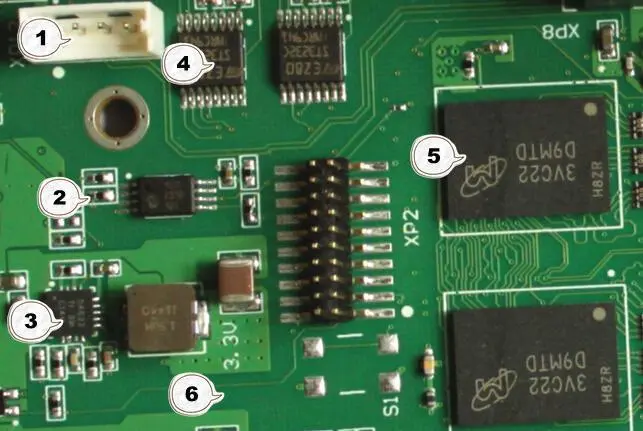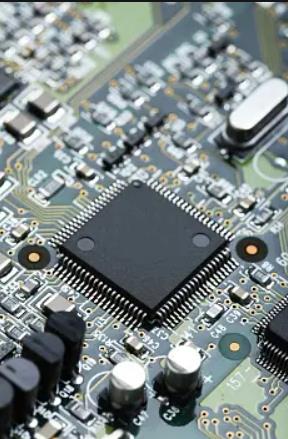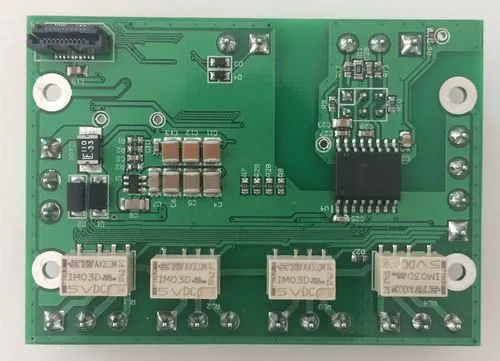
According to the mounting accuracy requirements and different types and quantities of components, the commonly used schemes are as follows:
Scheme 1. Multi piece mounting: multi piece FPC is positioned on the half of the bracket by the positioning template, and is fixed on the bracket in the whole process for SMT mounting.
1. Scope of application:
A. Component type: QFQ and other components with chip size greater than 0603 and pin spacing greater than or equal to 0.65 are acceptable.
B. Number of components: from several components to more than ten PCB components on each FPC.
C. Mounting accuracy: the mounting accuracy is required to be medium.
D. FPC characteristics: the area is slightly large, there are no components in the appropriate area, and each FPC has two MARK marks for optical positioning and more than two positioning holes.

2. Fixation of FPC: read the internal positioning data of FPC according to the CAD data of the metal bushing to manufacture high-precision FPC positioning template. Make the diameter of the locating pin on the template match the hole diameter of the locating hole on the FPC, and the height is about 2.5mm. There are two lower position pins of the support plate on the FPC positioning template. Make a batch of pallets according to the same CAD data. The thickness of the pallet should be about 2mm, and the warping deformation of the material after multiple thermal shocks should be small. Good FR-4 materials and other high-quality materials are preferred. Before SMT, the support plate shall be sleeved on the support plate locating pin on the template to expose the locating pin through the hole on the support plate. Cover the FPC piece by piece on the exposed dowel pin, and fix it on the supporting plate with thin heat-resistant adhesive tape to prevent the FPC from shifting. Then separate the supporting plate from the FPC positioning template for welding, printing and mounting. The heat-resistant adhesive tape (PA protective film) should be moderately adhesive and easy to peel after high temperature impact. There is no residual adhesive on FPC.
It should be noted that the shorter the storage time between the fixing of FPC on the pallet and the welding, printing and mounting, the better.
Scheme 2. High precision mounting: fix one or several FPC on the high-precision positioning pallet for SMT mounting
1. Scope of application:
A. Component type: Almost all conventional components, QFP with pin spacing less than 0.65mm can also be used.
B. Number of components: more than dozens of components.
C. Mounting accuracy: Comparatively speaking, the mounting accuracy of QFP with high mounting accuracy and maximum spacing of 0.5mm can also be guaranteed
D. FPC characteristics: large area, several positioning holes, MARK mark for FPC optical positioning and optical positioning mark for important components such as QFP.
2. Fixation of FPC: FPC is fixed on the component carrier plate. This kind of positioning pallet is customized in batch, with extremely high precision. The positioning difference between each pallet can be ignored. The size change and warpage deformation of the support plate are very small after dozens of high temperature impacts. There are two locating pins on this kind of locating bracket. The height of one locating pin is consistent with the thickness of the FPC, and its diameter matches the hole diameter of the locating hole of the FPC. The height of the other T-type locating pin is slightly higher than that of the previous one. Because the FPC is very flexible, large in area, and irregular in shape, the T-type locating pin is used to limit the offset of some parts of the FPC and ensure the printing and mounting accuracy. For this fixing method, the place on the metal plate corresponding to the T-shaped locating pin can be properly treated.
FPC is fixed on the positioning support plate. Although the storage time is not limited, it should not be too long due to the environmental conditions. Otherwise, FPC is easy to be affected with damp, causing warpage and deformation, which will affect the quality of mounting.
High precision mounting on FPC and process requirements and precautions 1. Fixing direction of FPC: Before making the metal bushing and supporting plate, the fixing direction of FPC should be considered first to reduce the possibility of poor welding during reflow welding. The preferred solution is to place the slice elements in the vertical direction and in the horizontal direction of the SOT and SOP.
2. FPC and plastic encapsulated SMD components are both "moisture sensitive devices". After absorbing moisture, FPC is easy to cause warping deformation and delamination under high temperature. Therefore, FPC, like all plastic encapsulated SMDs, should be protected from moisture at ordinary times, and must be dehydrated and dried before mounting. Generally, high drying method is adopted in large-scale production plants. The drying time is about 12 hours at 125 ℃. Plastic encapsulated SMD at 80 ℃ - 120 ℃ for 16-24 hours.
3. Preservation of solder paste and preparation before use: The composition of solder paste is complex. When the temperature is high, some components are very unstable and volatile, so the solder paste should be sealed in a low-temperature environment. The temperature should be greater than 0 ℃, 4 ℃ - 8 ℃ is the most appropriate. Before use, the temperature shall be returned to normal temperature for about 8 hours (under sealing conditions), when the temperature is consistent with normal temperature. It can only be opened and used after mixing. If the solder paste is opened for use before reaching the room temperature, it will absorb the moisture in the air, which will cause splashes and solder beads during reflow soldering. The water absorbed at the same time is easy to react with some activators at high temperatures, consuming the activators and causing poor welding. Solder paste is also forbidden to return to temperature rapidly under high temperature (above 32 ℃). Manual mixing should be carried out with even force. When the solder paste is stirred like thick paste, it can be lifted with a scraper and fall naturally in sections, indicating that it can be used. It is better to use a centrifugal automatic mixer, which has better effect, and can avoid the phenomenon that there are bubbles left in the solder paste when manually stirring, so that the printing effect is better.
4. Ambient temperature and humidity: generally, the ambient temperature is required to be about 20 ℃, and the relative humidity is required to be below 60%. Solder paste printing is required to be carried out in a relatively closed space with little air convection.
5. The thickness of metal bushing is generally 0.1mm-0.5mm. According to the actual effect, when the thickness of the leakage plate is less than half of the minimum pad width, the effect of solder paste peeling is good, and there is less solder residue in the leakage. The area of the leak is generally about 10% smaller than that of the pad.
Due to the accuracy requirements of mounting components, it is recommended to use chemical corrosion plus local chemical polishing method, laser method and electroforming method to make metal bushing if the common chemical corrosion does not meet the requirements. From the comparison of price and performance, the laser method is preferred.
1) Chemical corrosion plus local chemical polishing method: the chemical corrosion method is widely used to manufacture the bushing in China, but the hole wall is not smooth enough. The local chemical polishing method can be used to increase the smoothness of the hole wall. This method has low manufacturing cost.
2) Laser method: high cost. But with high processing precision, smooth hole wall and small tolerance, it is suitable for printing QFP solder paste with 0.3mm spacing.
6. Solder paste: According to the product requirements, general solder paste and non cleaning solder paste can be selected respectively. The characteristics of solder paste are as follows:
1) Shape and diameter of solder paste particles: the shape of solder paste particles is spherical, and the proportion of non spherical solder paste particles cannot exceed 5%. The diameter shall be in accordance with the general rule. The diameter of the solder ball shall be less than one third of the thickness of the metal bushing and one fifth of the minimum aperture width. Otherwise, the solder ball with too large diameter and irregular particles will easily block the missing print window, causing poor printing of solder paste. Therefore, the metal plate with a thickness of 0.1-0.5mm and the minimum leakage plate window width of 0.22mm determine that the welding ball diameter is about 40um. The proportion of welding balls with the largest and smallest diameter shall not exceed 5%. If the diameter of the solder ball is too small, its surface oxide will increase nonlinearly and rapidly with the diameter becoming smaller. In reflow welding, a large amount of flux will be consumed, which will seriously affect the welding quality. If the solder paste is free of cleaning, it has less oxide removing substances, and the welding effect will be worse. Therefore, spherical solder paste particles with uniform size and diameter of 40um are better choices.
2) Solder proportion: Solder paste with 90% - 92% solder content has moderate viscosity and is not easy to collapse during printing. After reflow soldering, the thickness is about 75% of that during printing. Sufficient solder can ensure reliable welding strength.
3) Viscosity: The flow mechanics of solder paste is very complex. Obviously, the solder paste should be easy to print and firmly attached to the surface of FPC. The low viscosity solder paste (500Kcps) is easy to collapse and form a short circuit, while the high viscosity solder paste (1400Kcps) is easy to remain in the metal leak, slowly blocking the leak, affecting the printing quality. Therefore, 700-900Kcps solder paste is ideal.
4) Thixotropy coefficient: generally 0.45-0.60
7. Printing parameters:
1) Type and hardness of scraper: because the particularity of FPC fixing mode is that the printing surface cannot be as flat as PCB and the thickness and hardness are consistent, it is not appropriate to use metal scraper, but polyurethane flat scraper with hardness of 80-90 degrees should be used.
2) The included angle between scraper and FPC is generally 60-75 degrees.
3) Printing direction: generally, it is left and right or front and back printing. The most advanced printing machine scraper is printed at a certain angle with the transmission direction, which can effectively ensure the printing amount of solder paste on the QFP four sided PCB pad, and the printing effect is the best.
4) Printing speed: within the range of 10-25mm/s. If the printing speed is too fast, the scraper will slide, resulting in missed printing. If the speed is too slow, the solder paste edge will be irregular or the FPC surface will be polluted. The scraper speed shall be in direct proportion to the pad spacing and in inverse proportion to the viscosity of the thickness of the bushing. When the printing speed of 0.2 mm wide solder pad leak is 20 mm/s, the filling time of solder paste is only 10 mm/s. Therefore, a moderate printing speed can ensure the printing amount of solder paste in fine printing
5) Printing pressure: generally set as 0.1-0.3kg/cm length. Since changing the printing speed will change the printing pressure, generally, first fix the printing speed and then adjust the printing pressure, from small to large, until the solder paste is just scraped off the surface of the metal bushing. Too little pressure will cause insufficient solder paste on the FPC, while too much printing pressure will cause the solder paste to print too thin, and increase the possibility that the solder paste will pollute the reverse side of the metal leak plate and the surface of the FPC.
6) Stripping speed: 0.1-0.2mm/s Due to the particularity of FPC, the slow stripping speed is conducive to the solder paste separating from the leak. If the speed is fast, the pressure of the air between the metal bushing and FPC and between the FPC and the carrier plate will change rapidly, which will cause the size of the gap between the FPC and the carrier plate to change instantaneously, affecting the separation of solder paste from the hole and the integrity of the printed pattern, resulting in defects. Now, more advanced printing presses can set the stripping speed to be accelerated. The speed can be gradually accelerated from 0, and the stripping effect is also very good.
8. Placement: According to the characteristics of the product, the number of components and the placement efficiency, the medium and high speed placement machine is generally used for placement. Since each FPC has an optical MARK mark for positioning, SMD mounting on FPC is not different from mounting on PCB. It should be noted that after the component placement is completed, the suction in the nozzle should be changed to 0 in time before the nozzle can be removed from the component. Although the improper setting of this process will also cause poor mounting when the PCB is later mounted, the probability of such poor mounting is much higher on a soft FPC. At the same time, pay attention to the lower pasting height, and the suction nozzle should not be moved too fast.









